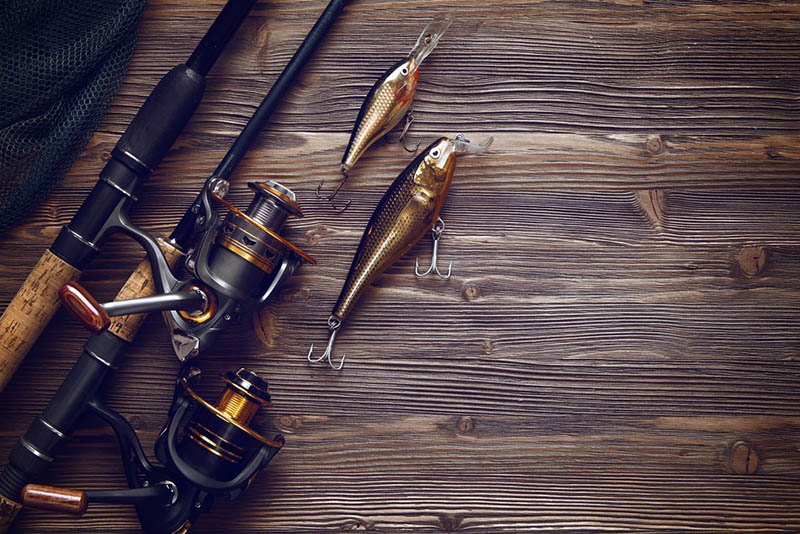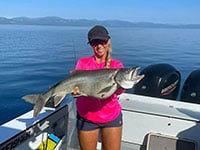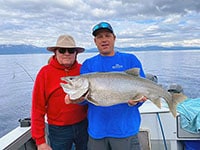The anticipation of your first cast in the early morning is an exciting moment. Steam is rolling off the water and the sun is cresting the mountain side. Giving you just enough light to see where you want to send that first cast. You really never know what can happen. That really is the thrill of fishing. You can lay out one beautiful cast in just the right place and have the sensation of a first cast bump and an instantaneous hook set. That’s a good start to the morning! At the same time nothing can be worse than laying down that perfect cast and watching the line slowly spin and wind into loops as it struggles to flow through the rod guides. Then you hear a dreaded snap and crackle as your lure continues into the water unattached to the line. You end up with a birds nest of line around your reel and a vocabulary selection that most grandmas would not approve of.
The best way to start off a good morning of fishing is the preparation the night before. Line is the most important factor in fishing. It should never be overlooked or underestimated. It can make or break your fishing experience. Since I was 6 years old my preparation for fishing always involved an evening worth of work. Aside from gathering all the best lures and planning out every cast of my morning I was always checking my line or changing my line. That same forethought continues to this day as a fishing guide on Lake Tahoe. When you’re first starting out nothing is easier to overlook than the line. This is most true when you’re using the fishing setup that Uncle Chuck has had in his garage for ten years. Your excitement to get out on the water can over value your consideration of line quality. It doesn’t matter if you’re using a $20 rod and reel or a $500 setup. I’ve seen professional fisherman lose giant fish because they’ve overlooked the condition of their fishing line. I’ve even fished tournaments with partners that lost one fish and a $2,000 payout because they didn’t check the condition of their line.
At the end of the day the only thing between you and your lure is the line.
There are many different types of fishing line to select from. Along with there being many types each angler has a different preference concerning line selection. What brand is better is up to the angler to decide. All lines are different (although they’re made similar). When selecting line you should first ask ourself what the difference is between monofilament and fluorocarbon line. They have obvious and yet subtle differences.
Lets start with monofilaments. It is often referred to as “Mono” and has been a staple product for traditional fisherman for many years. The biggest difference you will notice when you see it on the shelf at the store is the price tag. Mono is the cheaper of the two. It is a strong line and very durable when being used around structure. Mono is a water permeable line that suspends on top of the water. One drawback of permeability is that the line will become weak over time and it will need to be replaced more often than other lines. In the same way that mono is permeable, it is also stretchable (within reason). This can be a great attribute given the correct circumstances. Given that mono stretches and floats it is an ideal line choice for trout and bass.
For bass fishing mono is a good choice for crank baits, Carolina Rigs and in some cases topwater baits. The extra stretch when using crank baits keeps your hook (typically a treble) set when a fish starts to head shake or tries to turn and make a run. When it comes to Carolina Rigs mono will give your bait that extra lift off the bottom for better presentation. Baits tend to drag bottom more often when using fluorocarbon. Keeping your bait off the bottom means more bites. Topwater can be a very exciting way to fish. Nowadays bass fisherman use braid because it also floats and is extremely strong for the size of the line. Mono is necessary for topwater when fishing clear water with little vegetation that a bass would need to be “yanked” out of.
Trout fishing with mono is ideal for rivers and fishing from shore. The extra lift that mono provides is ideal when throwing spinners in the river or when throwing spoons from shore. It will give the lure a little more floatation and can keep it from immediately sinking in between the rocks. Mono is great for the river because it does offer durability when scraping along rocks and other types of structure. Worm fishing with mono is also ideal because it will give your worm a little more float. Don’t forget to float your worm! In Lake Tahoe fisherman often drift minnows with a Carolina rig. When fishing deep for Lake Trout it’s a great idea to use mono on just the leader of the Carolina rig. This gives the minnow a little extra lift and helps to fight them from hiding in the grass. If they’re in the grass you’re less likely to get a bite. You also get the benefit of a little extra stretch and durability when an angry Laker starts to head shake.
Now that we have a better understanding of monofilaments lets discuss fluorocarbon line (fluoro). Fluorocarbon is barely visible and some manufactures would even say its invisible to the fish. Its a great choice for fishing alpine lakes that are extremely clear. Fish can be line shy and less reluctant to bite if they can see the line. Using a good fluorocarbon line can minimize this effect. The reason fluoro is so clear is because of its density and it shares many of the same light refraction properties as water . This causes it to sink and prevents it from stretching as much as mono. The density of fluoro also makes the line a little rigid. That combined with limited stretch offers a very sensitive line. Being able to feel more bites is a big advantage and leads to more hook sets. Another advantage of the Fluoro is its resistance to UV. It holds up better to the elements and it will last longer. That is a bonus when considering the extra price of fluoro.
Fluoro is great for many applications. It is what I primarily use as a fishing guide on Lake Tahoe. Fluoro sinks and will allow your crank baits to dive deeper and it will also result in a faster hook set than mono as monos stretch will delay the hook set. Jigging is a great way to fish and fluoro has made jigging easier in deep lakes like Tahoe. The limited stretch and sensitivity of fluoro allows you to feel a bite and set the hook. When fishing 200+ feet deep, like we do in Tahoe, the less stretch we have in the line the better. Although fluoro doesn’t stretch much it will stretch when you have a lot of line out. So most guides will use braided line with a fluorocarbon leader of 30 feet or so. The same line setup is often used when trolling with down riggers. The leader length will very, but the combination of braid and fluoro results in more fish getting hooked. Fluro is also the first choice when top-lining, because it will allow your baits to dive deeper and it offers the best line invisibility for lure presentation.
Mono and fluoro have both have perks and downfalls. How anglers capitalizes on those strengths and weaknesses will determine how successful they are. Now that we have a better understanding of mono and fluoro lets go over the little things. When it comes to catching the big fish or losing the big fish it comes down to the small things. Test your line! Grab it and pull on it. If its brittle or breaks replace it. If it’s old but seems okay replace it. Our excitement to get on the water usually leads us to over look simply replacing line. “Oh, it’ll be fine. I’ll replace it next time out.” is what you tell yourself. Then you have a fish story of the big one that got away. Checking rod guide inserts is also another little detail that is ignored. Each guide on the rod has a tiny insert in it that is extra smooth for the optimal flow during casts and for minimal abrasion/friction when retrieving or catching. Sometime a little burr or rough section will form in that insert. Have you ever casted and your rod keeps cutting your line? Check your guide inserts. The best way to do it is with a q-tip. Roll the q-tip in the insert and if it rips any cotton of the tip it has an abrasion. The best way to avoid this is by using your hook keeper at the bottom of the rod instead of the guides.
The next little thing that is overlooked is retying your knots. Never expect your knot from yesterday to hold. Tie a new knot. The knot can take a lot of abuse. It’s often the loop that wraps the eyelet that is weak after a day of fishing. Even if you pull on it and it seems strong retie it. Test your knots and pull on them. The slightest mistake in knot tying can cause the line to cut into itself or a weak point. Sometimes the knot will simply slip. Test your knot! Once your in the water and fishing its not a concern in the back of your mind. Then you catch a fish. The fish is in the box and the morning is off to a great start. Check your line and knot before you send it back down. Run your fingers down the line to the lure and check for abrasions or even a small knot that was creating while unhooking the fish in the net. Then its back to fishing!




